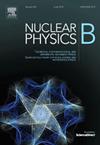An unified topological representation theory of the integral and fractional quantum Hall fluid by folding the membrane of quantum electron fluid
IF 2.5
3区 物理与天体物理
Q2 PHYSICS, PARTICLES & FIELDS
引用次数: 0
Abstract
How to understand the integral and fractional quantum Hall resistivity in an unified mathematical physics theory remained an unsolved problem in the past four decades. Here the quantum Hall fluid is modeled as electron fluid membrane that winds around magnetic fluxes. The train tracks of fractional quantum Hall fluid lies in the cross section edge surface of the folded membrane, which is spontaneously characterized by the knot lattice of magnetic fluxes in the bulk zone. The transition from the fractional Hall fluid to the integral Hall fluid is characterized by a geometric transformation in hyperbolic space. Both the integral and fractional Hall resistivity are unified into one exact resistivity equation, , , with respect to the bulk energy gap , that agrees with experimental measurements. This electron fluid membrane model provides a natural representation of Wen-Zee matrix formulation of topological fluid for quantum Hall effect under topological surgery and train track. When the electron fluid membrane in real space is mapped into momentum space, the Thouless-Kohmoto-Nightingale-Den Nijs (TKNN) formula of integral Hall conductance is generalized to fractional Hall conductance. The Thurston's train track in two dimensions is generalized to the folding laminar membranes in three dimensions, which predicted fractional quantum Hall fluid in three dimensions, and provided an analytical explanation on the measured competing phenomena between different fractional quantum Hall states. A fractional quantum Hall effect in hyperbolic space is predicted in the plane perpendicular to the conventional 2D electron gas in inhomogeneous magnetic field. This topological representation theory provides a different path to implement string theory and topological quantum computation by folding laminar quantum fluid.
求助全文
约1分钟内获得全文
求助全文
来源期刊

Nuclear Physics B
物理-物理:粒子与场物理
CiteScore
5.50
自引率
7.10%
发文量
302
审稿时长
1 months
期刊介绍:
Nuclear Physics B focuses on the domain of high energy physics, quantum field theory, statistical systems, and mathematical physics, and includes four main sections: high energy physics - phenomenology, high energy physics - theory, high energy physics - experiment, and quantum field theory, statistical systems, and mathematical physics. The emphasis is on original research papers (Frontiers Articles or Full Length Articles), but Review Articles are also welcome.
 求助内容:
求助内容: 应助结果提醒方式:
应助结果提醒方式:


